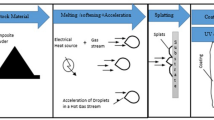Abstract
In order to use minimum time and save energy during siliconizing surface hardening of low carbon steel it is important to study the siliconizing parameters to obtain optimum conditions. In this work, the experimental design using the Taguchi method is employed to optimize the siliconizing parameters in the pack siliconizing surface hardening process. The siliconizing parameters evaluated are: siliconizing temperature, siliconizing time, silicon potential (ratio of silicon powder to bean pod ash (BPA) nanoparticle) and tempering temperature. The results showed that case depth and hardness values increased exponentially by increasing siliconizing temperature and time. Optimum values of hardness were obtained at a siliconizing temperature of 1000 ∘C, siliconizing time of 5 hours, silicon potential of 75 wt.% silicon/25 wt.% BPA and tempering temperature of 200 ∘C. With percentage contribution of: siliconizing temperature (79.86 %), siliconizing time (12.54 %), silicon potential (5.34 %) and tempering temperature (2.26 %). Silicon powder and bean pod ash nanoparticles can be effective for use as siliconizing materials in the ratio of 75 wt.% silicon/25 wt.% BPA. The activation energy (Q) for research work was determined as 333.89 kJ.mol−1. The growth rate constant (K) ranged from 6.78×10−8 to 2.05×10−6 m2.s−1. The case depth, hardness values and wear rate of siliconized mild steel at these operating conditions can be used for technological and industrial applications such as gears and cams.
Similar content being viewed by others
References
Ihom AP, Yaro SA, Aigbodion VS (2005) The effect of carburisation on the corrosion resistance of mild steel in four different media. J Corros Sci Technol 3:18–21
Ihom AP, Nyior GB, Alabi OO, Segun S, Nor IJ, Ogbodo JN (2012) The potentials of waste organic materials for surface hardness improvement of mild steel. Int J Sci Eng Res 3(11):1–20
Wang Kf, Chandrasekar S, Yang Hty (1997) Experimental and computational study of the quenching of carbon steel. Intl Jl Manufact Sci Eng 119(3):257–65
Palaniradja K, Alagumurthi N, Soundararajan V (2010) Hardness and case depth analysis through optimization techniques in surface hardening processes. Open Mater Sci J 4:38–63
Liu CC, Xu X, Liu ZA (2003) FEM modeling of quenching and tempering and its application in industrial engineering. Finite Elem Anal Des 39(11):1053–70
Pierre D, Peronnet M, Bosselet F, Viala JC, Bouix J (2002) Chemical interaction between mild steel and liquid Mg-Si alloys. Mater Sci Eng B 94:186–195
Gasa P, D’heurleb FM (1993) Formation of silicide thin films by solid state reaction. Appl Surf Sci 73:153–161
Yang HL, Cui CW, Li YG, Tang GZ, Zhang YZ (2011) Growth kinetics and microstructure of siliconized layer by molten salt electrodepositi. Adv Mater Res 214:434–438
Perez-Mariano J, Elvira J, Plana F, Colominas C (2006) Siliconization and nitridation of steels in a fluidized bed reactor. Surf Coat Technol 200:5606–5610
Grünling HW, Bauer R (1982) The role of silicon in corrosion-resistant high temperature coatings. Thin Solid Film 95:3–20
Stott FH, Wei FI (1989) Comparison of the effects of small additions of silicon or aluminum on the oxidation of iron-chromium alloys. Oxid Met 31:369–39
Basu SN, Yurek GY (1991) Effect of alloy grain size and silicon content on the oxidation of austenitic fe-cr-ni-mn-si alloys in pure o. Oxid Met 36:281–315
Hsu HW, Tsai WT (2000) High temperature corrosion behavior of siliconized 310 stainless steel. Mater Chem Phys 64:147–155
Atuanya CU, Aigbodion VS (2014) Evaluation of Al–Cu–Mg alloy/bean pod ash nanoparticles synthesis by double layer feeding–stir casting method. J Alloys Compd 601:251–259
Author information
Authors and Affiliations
Corresponding author
Rights and permissions
About this article
Cite this article
Popoola, A.P.I., Aigbodion, V.S., Fayomi, O.S.I. et al. Experimental Study of the Effect of Siliconizing Parameters of Thermochemical Treatment of low Carbon Steel. Silicon 8, 201–210 (2016). https://doi.org/10.1007/s12633-015-9387-3
Received:
Accepted:
Published:
Issue Date:
DOI: https://doi.org/10.1007/s12633-015-9387-3




